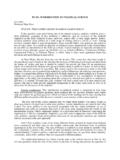Transcription of Globalization: Challenges and Opportunities - CAPWIP
1 globalization : Challenges and Opportunities by: Solita Monsod PROFESSOR, UNIVERSITY OF THE PHILIPPINES. I. Introduction: In the wake of the demonstrations that accompanied the Third Ministerial Meeting of the World Trade Organization in Seattle, the World Economic Forum Meeting at Davos, and the 10th UN Conference on Trade and Development in this city, more and more questions are being asked about the path that globalization is taking, doubts are being raised about the wisdom of that path, and calls are being made . both in developed and developing countries -- for reform by some, and for abolition by others, of the WTO, which has become the main symbol of a globalizing world . As parliamentarians, you are in a unique position to participate in the debate and contribute to its clarification and to its resolution, both in your own countries and in official international forums. Three possible outcomes are possible, depending on how issues are resolved: a world where unhampered market forces overwhelm state institutions and indigenous social cultures, a managed globalization where equity is at least as strong a driving force as efficiency, or a protectionist world where flows of trade, investment and information are obstructed in the name of nationalism.
2 Obviously, the stakes are high. This paper hopes to provide the participants of this conference an overview of globalization and the issues surrounding it. We start, in the next section, by attempting to define globalization , providing illustrations of what it is all about. The third section reviews the positive and negative impact of globalisation, looking at some gainers and losers both between and within countries, with particular emphasis on women. The succeeding section highlights three reasons why the benefits of globalisation are very unequally distributed. Section 5 discusses the options that are available to reduce those inequalities minimizing the damage and maximizing the Opportunities of globalization . The last section makes some specific suggestions and recommendations regarding the courses of action that parliamentarians can take to ensure such an outcome. There is no use reinventing the wheel.
3 Most of the materials presented in this overview are drawn from the 1997 and 1999 Human Development Reports (HDR) of the UNDP, which in turn draw from several commissioned background papers and special contributions as well as a very rich lode of research done on different aspects of globalization . The 1999 HDR deals entirely with globalization , while the 1997 HDR. devotes one chapter to it. They are highly recommended as reading material, as are the other HDR's, which have been published yearly since 1990. Needless to say, I take responsibility for any errors made in my attempts to summarize and reformat the information for this conference. II. Definitions, Illustrations Page 1 of 10. globalization may be defined in several ways , and from different perspectives. One can talk about globalization as the widening and deepening of international flows of trade, finance and information in a single, integrated global market.
4 An alternative would be to describe it as the increasing linkages between the world's people (including the international spread of cultures as well as diseases and crime) as natural and artificial barriers fall. Or, one can refer to it as the transformation (shrinking) of the world into a global village, as borders disappear, distances shrink, and time shortens. The fall of natural barriers, the shrinking of space and time, can be illustrated by the trend in sea and air transport costs as well as the costs of Average ocean freight and port charges per ton fell by more than two-thirds between 1920 and 1990, from US$95 (in 1990 US$) to $29. Air transport costs have decreased even more, and travel times have also been shortened. Average revenue per passenger mile fell by more than 80% between 1930 and 1990, from US$ to US$ In 1950, it took four days to fly from Manila to New York. It now takes under a day.
5 The largest cost and time reductions have occurred in communications. The cost of a 3-minute international call between New York and London fell from US$245 (in 1930) to US$32 in 1970 to US$3 in 1990. At present, it costs less than US$ Documents can now be transmitted by fax in a matter of minutes, and by e-mail instantaneously, compared to days, weeks, and even months half a century ago. The cost of computers in 1960 were 125 times what they were in 1990, which in turn were more than double what they cost now. Artificial or man-made barriers to trade such as tariffs and quotas have also been brought down. Other artificial barriers of a more political and social nature, such as the cold war and apartheid have likewise been toppled. In 1947, average tariffs on manufactured imports were 47%, but by 1980 they were down to 6%, and by the time the Uruguay Round is fully implemented, they will go down to 3%.
6 At the same time, controls over the flows of capital have been lifted, particularly after the Bretton Woods system of fixed exchange rates broke down in 1971, with developed countries leading the way, and developing countries following, encouraged in no small degree by the Bretton Woods institutions and the OECD. The same trend is observable with regard to foreign exchange flows. It must be pointed out, however, that globalization is not a new phenomenon. It has happened before, probably even on a larger scale, as was the case over a century ago. Towards the end of the nineteenth century, trade flows were roughly the same proportion of national income as they are today, while capital transfers were relatively even larger, and movements of people far greater than they are today, when immigration is much more restricted. What is different about the current globalization is not so much the scale of flows, but their character.
7 While it has become a dominant force in the last decade of the twentieth century as it was in the last decade of the nineteenth, it has new features: new markets ( , globally linked financial markets working around the clock with new instruments, global consumer markets with global brands, e- commerce), new actors ( , multinational corporations, the World Trade Organization, proliferation of international NGO's, regional blocs, policy coordination groups), new rules (multilateral agreements in trade, conventions on human rights, on global environment), and new tools of communication ( , cell phones, faxes, e-mail). Page 2 of 10. III. Impact of globalization : The Good and the Disturbing A. THE GOOD NEWS : globalization has many positive, innovative and dynamic aspects, all related to the increased market access, increased access to capital, and increased access to technology and information which have led to greater income and employment Opportunities .
8 There is no dearth of examples: The world as a whole is definitely more prosperous and more healthy, with average per capita incomes tripling in the last fifty years, child mortality rates halving and life expectancy increasing by ten years since 1965. Trade flows also increased 12-fold in the past fifty years as a result of the removal of natural and artificial barriers. Exports are now US$7 trillion a year, with more than a fifth of the world's goods and services being traded. Capital flows expanded even faster, with Foreign Direct Investment amounting to US$400 billion in 1997, seven times its real level in the 1970's and portfolio and other short-term capital flows amounted to US$2 trillion in gross terms, three times what they were in the 80's. These in turn pale in comparison with what has happened in the foreign exchange markets, where volumes increased over a hundred times between the mid-70's and the mid-90's, with a US$ trillion daily turnover in 1998.
9 At the same time, international bank lending grew more than sixteen times, from US$265 million in 1973 to US$ trillion in 1994. The Uruguay Round of the General Agreement on Tariffs and Trade (GATT), which has given globalization greater impetus in the last decade, is expected to increase global income by an estimated US$212-US$510 billion (from trade and efficiency gains and higher rates of return on capital) by 2001. Movements of people have also increased. Tourism more than doubled between 1980 and 1996, from 260 million to 590 million travellers a year. Despite tight restrictions, international migration continues to grow, and workers' remittances amounted to US$58 billion in 1996. In the information and communications area, time spent on international telephone calls more than doubled between the first and second half of the last decade from 33 billion minutes in 1990 to 70. billion minutes in 1996.
10 At the same time, travel, the internet and the media have stimulated an exponential growth in the exchange of ideas and information: 28,000 international NGO's in 1993. where there were less than 600 in 1964, As of mid-1998, there were an estimated 139 million internet users, with the number of new subscribers doubling every year. The revolution in information and communication technology, for example, have allowed people in the remotest villages access to the most modern medical advice, while the potential for education is tremendous. B. THE DISTURBING NEWS : While the world as a whole has benefited from globalization , there are negative and marginalizing aspects of globalization . These are what have led to a backlash, as reflected to a certain extent in the demonstrations by civil society accompanying recent international conferences, and by increasing expressions of dissatisfaction at the governmental level.







